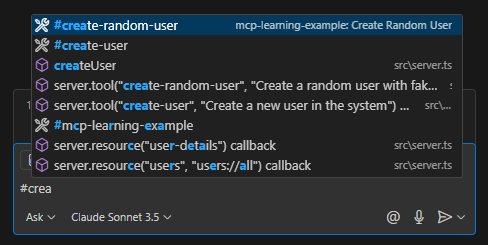References Web Dev Simplified YouTube channel as the source of learning material for the MCP implementation, though does not appear to provide direct YouTube API integration.
Model Context Protocol (MCP) Learning Notes
Video Reference
Source: Web Dev Simplified YouTube Video
Credits: Web Dev Simplified (YouTube channel)
Related MCP server: Violett MCP Server
What is MCP?
Model Context Protocol (MCP) is a protocol that defines how a client (such as an LLM) can communicate and use tools and resources defined at the server level. It implements a client-server architecture with the following components:
Tools
Resources
Prompts
Samplings
Documentation & Resources
Official documentation: modelcontextprotocol.io/introduction
Includes starter projects in multiple languages for MCP client and server implementation
Implementation Details
Server Setup
The src/server.ts file contains the code for creating an MCP server and defining tools, resources, and prompts.
Testing the Implementation
Build the server:
npm run server:buildAdd to VS Code using the "Add MCP server" command
Access server functionality in the Copilot chat UI
Use "#" followed by tool name to access implemented tools

Client Implementation
Note: to use the query and prompts from the client you will need a gemini ai api key, you can add this in the .env file
The src/client.ts file provides a CLI client for interacting with the MCP server. It connects to the server, lists available tools, resources, and prompts, and allows you to:
Query the LLM directly
Run tools (with parameter input)
Access resources (with dynamic URI parameters)
Use prompts (with argument input)
How it works
Connects to the MCP server using a transport layer.
Fetches available tools, resources, prompts, and resource templates.
Presents a menu for the user to select an action: Query, Tools, Resources, or Prompts.
Handles each action:
Query: Sends a prompt to the LLM and optionally invokes tools.
Tools: Lets you select and run a tool, entering parameters as needed.
Resources: Lets you select a resource or template, entering URI parameters if required, and displays the result.
Prompts: Lets you select a prompt, enter arguments, and view the generated output.
For prompts, you can choose to run the generated text through the LLM for further results.
Example Usage
When you run the client, you'll see a menu:
Selecting an option will guide you through the available features interactively.
Resources
users: Retrieves all users from the JSON file
user-details: Retrieves user details by ID
Tools
create-user: Creates a new user with the following parameters:
username
email
address
age
phone number
create-random-user: Generates and creates a random user
Prompts
generate-fake-user: Prompt with fixed fields for generating fake user data
Sampling
create-random-user: This uses sampling i.e. calling requests on the LLM or clientto generate something.